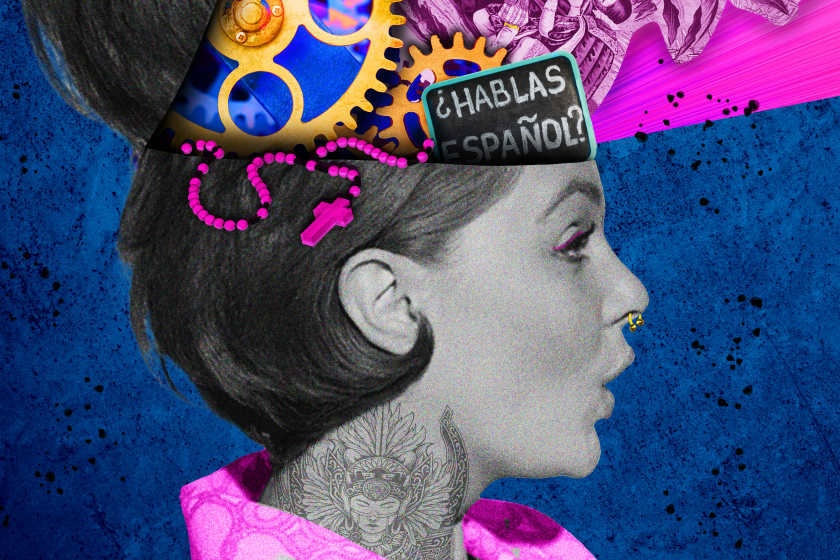
- Share via
In recent years, political turmoil in Venezuela has driven many people there to seek new lives abroad. This displacement has ignited a profound longing for their homeland — nostalgia for cherished sights, sounds and flavors that connect them to their origins. Finding solace in these small connections has become a lifeline for many. Paola Santos’ charming debut picture book, “How to Eat a Mango,” published in July by Neal Porter Books, offers just that — a sweet, comforting slice of home.
The story follows young Carmencita, who initially resists her abuelita’s insistence on picking mangoes from their garden. They are just messy and get stuck in her teeth, more of a chore than a treat. But Abuelita, with her gentle wisdom, guides through a mindful journey. Together, they explore the tree and the sweet, smooth fruits, encouraging Carmencita — and young readers — to appreciate nature’s gifts and the love that comes with them.
Santos was born in Maracaibo, a vibrant city and the birthplace of many beloved Venezuelan musicians, including Latin Grammy winner flutist Huáscar Barradas. It is also a place where mangoes are a staple. They now represent her culture, her beloved city left behind and moments enjoyed with loved ones.
“We had four mango trees in our backyard,” Santos tells The Times in her native Spanish. “The mango tree was always very important to me in my childhood. I used to sit under it to think, to listen to the wind through the leaves and imagine what the tree was telling me.”
In this issue of De Los Reads, we explore six books that pave the way for a more inclusive and authentic expression of our Latino identities.
Maracaibo is regarded as “la tierra del sol amada,” or the sun’s beloved land, because of its bright sunlight and hot temperatures throughout the year.
Mangoes are a depiction of that element and the richness of Venezuelan traditions. Santos writes in the book, “The sweetness of Mamá Earth is endless when you bite a ripe mango … the songs of our people dance on your tongue.”
The author’s immigration experience has been a catalyst for her writing. The emotions and uprooting ignited the need to write at a feverish pace, filling the pages of notebooks with poems to let those feelings out.
“It was like releasing the genie from the bottle,” Santos says. “The uprooting from your people, feeling that you are no longer in that place, with your family, the customs, the music — you miss it.”
For Santos, nostalgia doesn’t mean sadness. Instead, she remembers the past lovingly, like her childhood in Venezuela, a period she holds dearly, and has hope for the country’s recovery. A sense of optimism has emerged as Venezuelans persist in their fight for recognition of the latest election results.
Spanish “will always be the heartbeat of my soul,” said Santos, who adds that mastering English has been a monumental achievement. “People don’t understand how difficult it is to write in a second language when you have learned the language as an adult. I feel like I have conquered Everest.”
Battling her doubts with patience and resilience, she now finds joy in using English and has embraced the duality of her life with joy.
The multi-hyphenate musician from Puerto Rico, Jhayco, rethinks his craft on “Le Clique: Vida Rockstar (X).” Looking to his contemporaries for inspiration, the record stands as a 29-track explorative trilogy.
In her book, she inspires families to immerse themselves in the present by actively listening and be fully engaged by using their senses to touch, feel and taste the wonders around them. She believes that by slowing down and savoring life’s beauty, children can develop a deep appreciation of nature, understanding how quickly time can pass.
Another essential element for the writer is the representation of Venezuela in literature, especially in children’s books.
“There is not much Venezuelan representation; there are few things that you can see about us as a people,” she said. This is why she values the work of Juliana Perdomo, the Colombian-born artist who illustrated her book, vividly showcasing the atmosphere, musical instruments and dances of Venezuelan culture. Her artistic passion for children’s literature give Carmencita and Abuelita a distinctive look that radiates the wisdom and warmth of the Venezuelan people. The book, Santos said, would not have been the same without Perdomo’s art.
“How to Eat a Mango” is a delightful story for the whole family, a gentle reminder to appreciate the little moments and recognize all the love that surrounds us. The sweet and nourishing book, which will inspire readers to reflect on their life journey, is also available in Spanish: “Cómo se come un mango.”

De Los Reads picks:
“El cementerio de los cuentos sin contar” (Spanish edition) by Julia Alvarez (HarperCollins Español)
This novel is a brilliant blend of magic and reality. Alma Cruz, a writer haunted by unfinished tales, creates a literal graveyard for her characters — only to find them talking back and reshaping their own fates. The book is a captivating exploration highlighting Alvarez’s imaginative take, reminding readers that stories have a life of their own.
“Peaceful Kitchen” by Catherine Perez (HarperOne)
Perez’s cookbook is a breath of fresh air for anyone diving into plant-based cooking. With a delicious mix of Mexican and Dominican flavors, she brings a personal touch to every recipe. From crispy buffalo white bean tacos to baked hummus pasta, this book proves that eating well can be exciting and easy. Perez’s down-to-earth approach and flavorful twists make this a must-have for anyone looking to enjoy nutritious meals without sacrificing taste.
“Angélica and la Güira” by Angie Cruz, illustrated by Luz Batista (Kokila)
This heartwarming picture book dances with life and culture. Through Angélica’s summer in the Dominican Republic and her return to Washington Heights, Cruz paints a vibrant picture of how music shortens distances and connects communities. The güira, a unique musical gift from her grandfather, becomes a symbol of joy and unity. With lively illustrations, it’s a celebration of family, tradition and music’s magic that would make kids dance.
More to Read
The Latinx experience chronicled
Get the Latinx Files newsletter for stories that capture the multitudes within our communities.
You may occasionally receive promotional content from the Los Angeles Times.








